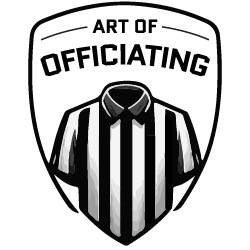Over the years, I’ve reviewed hundreds of hours of Hudl film (I’m close to earning my slow-motion video Ranger tab). I often send plays to trusted officials with a “what do you think” query. Often, the responses are varied, with some agreeing with a flag and others stating that there is no foul.
In officiating, we’re familiar with the “when in question” axioms: when in question, the runner is down and has not fumbled… when in question, the quarterback threw a pass instead of fumbling… when in question, a pass is incomplete instead of caught.
But that’s not what this article is about. This isn’t about plays where we’re unsure if a pass was complete or incomplete or if a runner was downed before the ball came loose.
This article refers to situations where the covering official has clearly witnessed the beginning, middle, and end of the action. You’ve observed everything you need to. Now, you’re asking yourself: “Does this rise to the level of a foul?” and you’re legitimately “on the fence.”
That’s a 50/50 call.
In my opinion, with some 50/50 fouls, we should lean toward passing. There are categories of fouls that must scream to be called. If you are on the fence, don’t flag it. These include:
- Defensive Pass Interference
- Holding
- Blocking in the Back
- Block Below the Waist
- Illegal formation, motion, and shift
- False Start
- Encroachment
- Ineligible Receiver Illegally Downfield
For these, the standard is simple: The foul needs to “scream.” If you “think” it’s a foul, it isn’t. You need clear material impact on the play.
In my opinion, with other 50/50 fouls we should lean toward a flag. These “other” fouls involve player safety. Here, the standard shifts. We don’t flag just because something looks hard or violent. Our job is to determine whether the action poses a safety risk. If you clearly see the whole play and you’re on the fence, toss the flag.
- Roughing the Kicker
- Roughing the Passer
- Illegal Blindside Block
- Illegal Block by Team K During a Free Kick
- Late Hits
- Unnecessary Roughness
The key isn’t to say, “Call every safety foul if it’s close.” The key is: If you clearly saw the whole play but are uncertain whether it met the foul threshold, lean toward tossing the flag.
Think of it this way: Not every 50/50 call is created equal.
With 50/50 competitive balance fouls (holding, DPI, block in the back), keep the flag in your pocket.
50/50 safety fouls deserve the opposite treatment. If you clearly see the action and are genuinely torn, choose to flag the action.
Quiz
Read the quiz stem and then choose the best answer.
Snapper A55 initiates the snap with a quick, continuous backward motion. Before A55 releases the ball, B77 anticipates the snap and slaps the ball out of A55’s hand without contacting A55’s hand or arm.
- Legal
- Foul for encroachment
Review Rule 7-1-6c
